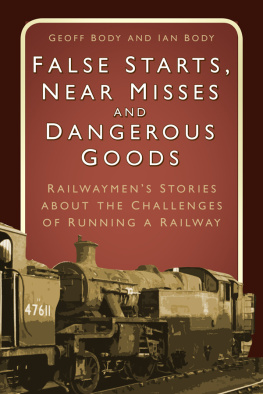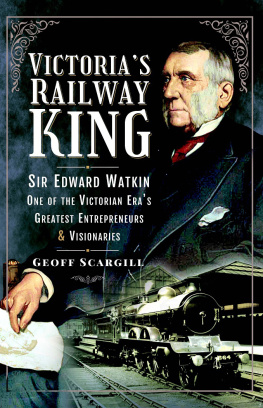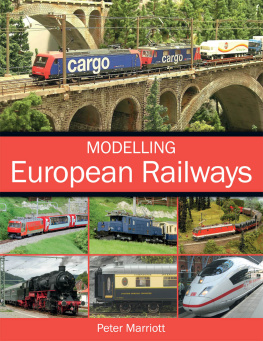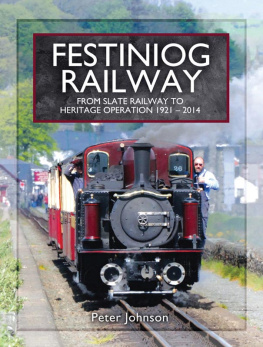


Arriva Train Wales unit 150230 runs into Platform 7 at Cardiff Central with a Valleys service heading for Barry Island.
Cover illustration: A scene of locomotive neglect typical of many places with the coming of the end of steam.
First published in 2017
The History Press
The Mill, Brimscombe Port
Stroud, Gloucestershire, GL5 2QG
www.thehistorypress.co.uk
This ebook edition first published in 2017
All rights reserved
Geoff and Ian Body, 2017
The right of Geoff and Ian Body to be identified as the Author of this work has been asserted in accordance with the Copyright, Designs and Patents Act 1988.
This ebook is copyright material and must not be copied, reproduced, transferred, distributed, leased, licensed or publicly performed or used in any way except as specifically permitted in writing by the publishers, as allowed under the terms and conditions under which it was purchased or as strictly permitted by applicable copyright law. Any unauthorised distribution or use of this text may be a direct infringement of the authors and publishers rights, and those responsible may be liable in law accordingly.
EPUB ISBN 978 0 7509 8189 7
Original typesetting by The History Press
eBook converted by Geethik Technologies
CONTENTS
INTRODUCTION, SOURCES AND ACKNOWLEDGEMENTS
Transport is a highly complex business, nowhere more so than in its railway arm. Paradoxically, it is an industry that seeks constantly and earnestly to be routine and orderly but stands no chance of total and consistent achievement of that objective. There is no certainty in the day-to-day operation and the plan, however carefully organised, is always liable to interruption: an unexpected influx of passengers, mechanical breakdown, the vagaries of weather, the acts of trespassers and vandals the possibilities are endless.
A great dividend from this uncertainty is that railwaymen are permanently schooled and ready to deal with the unexpected and challenging. Indeed, they have been doing so since the birth of the railway. It follows that significant incidents in a railwaymans career tend to be etched deeply in his memory and the aim of False Starts, Near Misses and Dangerous Goods has been to unearth a range of these recollections and put them together in a readable and entertaining form that also reveals something of the complexities of the railway business and how the industry is organised to manage them.
The writers between them have a good few, strong memories of their own, but this book could not have been prepared without the huge input from its contributors. Most of them are names that have appeared in the acknowledgements in previous books, and to everyone mentioned in the heading for each entry we are extremely grateful. To single out anyone would be an invidious task but, once again, Bryan Stone has done us proud from his photographic library, recalling in his present home in Switzerland the years when his wisdom resulted in a record of the detail of railway working that others had overlooked. New contributor David Barraclough has poured out a wealth of material from his time at Boston, Wath and Glasgow, and this book would not have happened without the efforts of long-term colleague and good friend Bill Parker. For inspiring contributions, his ideas, checking and much other help, thank you Bill.
As so often before, Amy Rigg and the editorial staff at The History Press have combined efficiency with unending helpfulness. Our thanks to them and the promotion, sales and other folk at The History Press.
Except where otherwise credited, the illustrations used in the book are all from the authors collections.

The departure board at Basingstoke gives echoes of the past: Burford, Itchen Abbas, Torrington, Bideford, Lynton stations long gone.
GLOSSARY
absolute block | standard railway signalling arrangement, ensuring only one train can be in a designated track section at a time |
ASLEF | Associated Society of Locomotive Engineers and Firemen |
bay platform | dead-end station platform |
BG | Brake Gangwayed (guards brake van/parcels van with bogie wheels) |
bogie | the framework carrying wheels which, in turn, is fixed to the railway vehicle |
bogie bolster wagon | long wheelbase flatbed freight vehicle |
BR | British Rail |
BRB | British Railways Board |
BRSA | British Railways Staff Association |
BSK | Brake Standard Corridor (second-class corridor passenger coach with brake section) |
BT | British Transport |
BTP | British Transport Police |
catch points | a safety turnout designed to derail vehicles running back out of control |
CI | Cras Iompair ireann (Irish Railways) |
clamping/clipping and scotching | a clip and a wedge used to immobilise a set of points (often for engineering work) |
conrail | conductor rail in direct current, third-rail electrified systems |
CP | Canadian Pacific |
demurrage | charge made to freight customers when wagons were not released within the stipulated period |
DI | District Inspector, often seen as the key local rules and operations expert |
DOO | Driver Only Operation (no assistant in the driving cab) |
DMU | diesel multiple unit |
DTM | Divisional Traffic Manager |
ECS | empty coaching stock (passenger vehicles running out of service) |
EMU | electric multiple unit |
facing and trailing points | facing points are divergent and allow a change of a trains direction, while trailing points are convergent |
four foot | space between the two running rails |
fully fitted | the existence of braking operated by the locomotive on all the vehicles in the train |
GWR | Great Western Railway |
hot axle-box | lack of lubricant on the axle-box, which can cause the metal to overheat and possibly fracture |
Next page
















